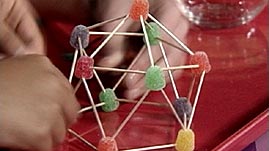The gumdrop domes in this video resource are modeled after geodesic domes. Beginning in the 1950s, American architect and engineer Buckminster Fuller popularized this fresh, and in some ways better, take on the centuries-old dome. A geodesic dome is made of many similar but smaller interconnected shapes. The shapes are configured to form a rigid, almost spherical framework in which forces are evenly distributed among the dome's individual members, called struts.
Triangles are particularly stable shapes, so they are great to use in building geodesic domes as well as other structures. They don't twist, bend, or collapse easily, in contrast with rectangles and other shapes. A push on a corner of a square, for example, produces a diamond shape. You can't change the shape of a triangle without altering the length of one of its sides.
A geodesic dome is a particularly good choice if you want to build an enclosed structure with lots of open interior space that is strong, lightweight, and easy to assemble. Every strut braces every other strut, and the structure's curvature distributes weight so that all of the struts share the load. That's right, a geodesic dome's spherical shape and framework construction actually allow it to support its own weight without the need for floor-to-ceiling columns, thick walls, or other obstructions.
Although the
ZOOM cast members test the strength of gumdrop domes under an externally applied load -- the weight of books -- geodesic and other domes are not designed to perform this function in the real world. Nevertheless, the activity effectively demonstrates that you can build rigid structures using a strong fundamental shape and relatively little building material.


 Loading Standards
Loading Standards Teachers' Domain is proud to be a Pathways portal to the National Science Digital Library.
Teachers' Domain is proud to be a Pathways portal to the National Science Digital Library.
